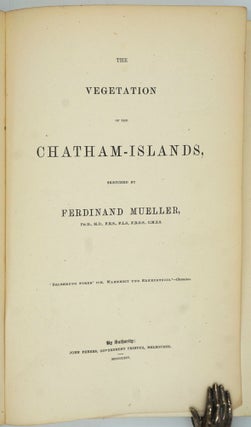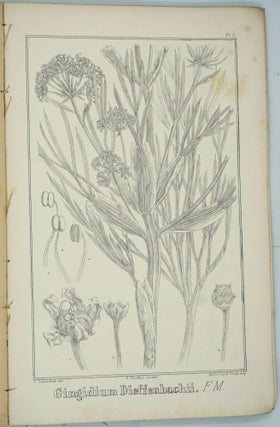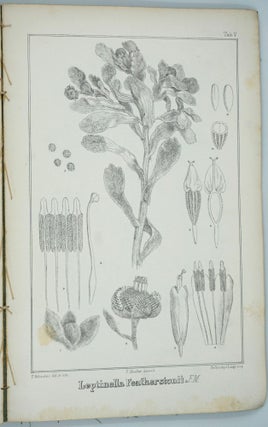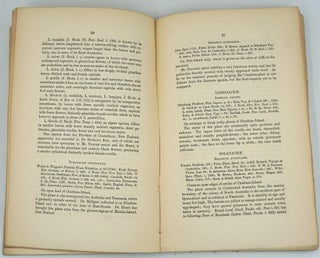The Vegetation of the Chatham-Islands. Sketched by Ferdinand Mueller.
Melbourne: John Ferres, 1864. Inscribed by two of the most important figures in the history of Australian natural history. Rare on the market (the print run was just 522) and a presentation copy from the author to La Trobe, the 1st Lieutenant-governor of the colony of Victoria (the man who oversaw the establishment of the Botanical Gardens in Melbourne, who hired Mueller in Australia and who had "extensive knowledge of Australian plants" [Desmond]. La Trobe was widely traveled (including an expedition with Washington Irving, who described him as "a citizen of the world, easily adapting himself to any change). The present work, the first Chatham Island flora, relies almost entirely on the specimens collected by Henry H. Travers in 1864.
Ref: Pritzel 613; Bagnall, 3664; R. Desmond Dictionary [1994] pp 415, 505 and 690.
Mueller's presentation inscription hints at the battle that raged between the supporters of Intelligent Design and the followers of Darwin and Natural Selection. Mueller (and probably La Trobe) were in the former camp. It reads:To Ch. Jas. La Trobe Esq., C.B., a man alike distinguished by leaning and philosophical piety, the author offers this trifling work, in which he arrays his opinions with those, who uphold our Christian faith on doctrine of natural philosophy. Melbourne 25 Dec. 1865." La Trobe's presentation is to the "Worcestershire Natural History Society presented by Chs. Jos. La Trobe Esq. C.B." This is the Worcester Natural History Society (of Worcester, Massachusetts) which was first formed in 1825 as the Worcester Lyceum of Natural History and united with the Worcester Lyceum in November 1829. The Society has been known by various names throughout its history, and as of 1998, is known as the Worcester EcoTarium (1998).
Sir Joseph Dalton Hooker, one of Darwin's closest friends, took a dim view of Mueller's abilities in general and of his intention to publish the present work in particular; writing to J. Haast in 1864 of his hope "...that Mueller will not publish Travers' Chatham Island plants. He is so reckless and careless - he is an excellent, most assiduous, marvelous man, but craves to have F. Muell. after every name... He has made chaos of Australian botany". (See https://www.rbg.vic/gov.au/documents/Muelleria_11,_p13-25, _Connor,_vegetation_Chatham_Islands.pdf)
Ferdinand Mueller "as appointed government botanist for Victoria by Governor Charles La Trobe in 1853, a post that was newly created for him. He examined its flora, especially the Alpine vegetation of Australia, which was previously unknown. He explored the Buffalo Ranges, then went to the upper reaches of the Goulburn River and across Gippsland to the coast. The neighborhoods of Port Albert and Wilson's Promontory were explored and the journey of some 1,500 miles was completed along the coast to Melbourne.
In the same year, he established the National Herbarium of Victoria, which can still be visited today. It has many plants from Australia and abroad, many of which were collected by Mueller. Also, his large library was transferred to the government of Victoria in 1865 and is incorporated into the library of the herbarium in Melbourne.
The next year, he joined the expedition sent out under Augustus Gregory, exploring the Victoria River and other portions of North Australia, and was one of the four who reached Termination Lake in 1856, and accompanied Gregory's expedition overland to Moreton Bay. He found nearly 800 species in Australia new to science. He published in this year his Definitions of Rare or Hitherto Undescribed Australian Plants.
"Henry Hammersley Travers was born in 1844 and arrived in New Zealand (Nelson) in 1850. He was educated at Nelson College, and admitted to the New Zealand bar as a lawyer in 1876. He practiced in Wellington, and later lived in Parapararumu.
Henry Travers made two trips to the Chatham Islands, where he collected important plant, bird and insect specimens, together with lizards, rock samples, whale bones, and Moriori artefacts. The first trip was funded by his father, W.T. L Travers, in 1864. The second trip was in 1871, and was possibly on behalf of the Colonial Museum.
In 1869 he married Ida Smith of Christchurch, and they had five children. Travers collected extensively from the Nelson Province and possibly purchased bird specimens from Nelson taxidermists. He made trips to Stephens Island in search of the then just-extinct Lyall's wren in February and December 1895 and again in 1903, to the subantarctic islands, and many other places.
Lyall's wren (Traversia lyalli) and the black robin (Petroica traversi) were named after Henry Travers.
Travers seems to have failed as a lawyer and lost his practise by 1900. He was appointed Curator of the Newtown Museum on 10 November 1913 but was dismissed some time in 1915. He died in 1928, and his wife Ida died in 1937, apparently bequeathing his large remaining collection of birds to the Dominion Museum (accessioned in 1944). " (Museum of New Zealand).
8vo (9 1/2 x 6 1/8") Pp. [i-iv; 1-] 86 [-88]p & 7 uncolored lithographic plates by ad after Frederick aka Fritz Schoenfeld (1810-1868) printed by De Gruchy & Leigh. Blindstamp to title, 2 final leaves of index and plates. Bright publisher's green diaper-grained cloth, titled in gilt on the front cover/
Provenance: Charles Joseph La Trobe (presentation inscription from Mueller); "Worcestershire" (but Worcester Massachusetts) Natural History Society (presentation inscription from La Trobe); Worcester Public Library (label at front, blindstamps, gilt shelf mark to spine). Item #26345
Sold







